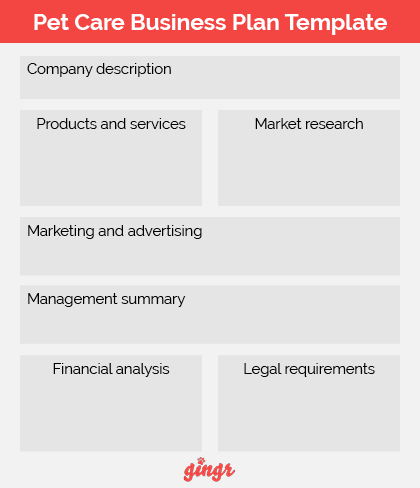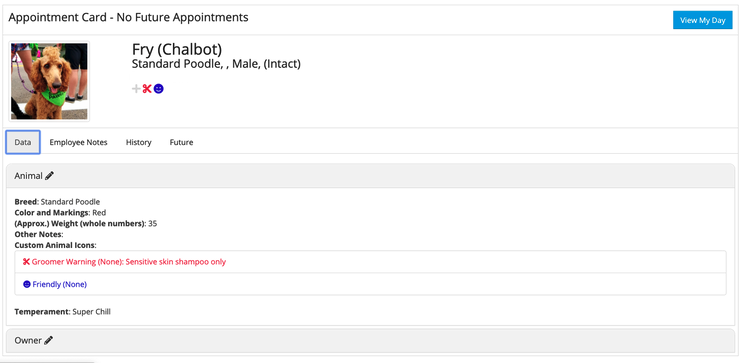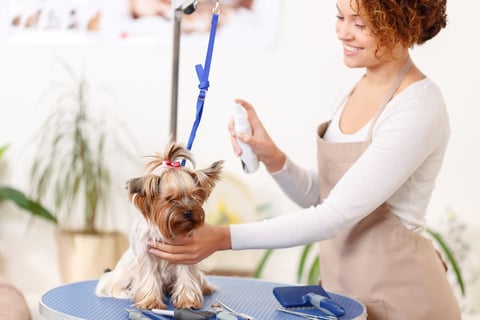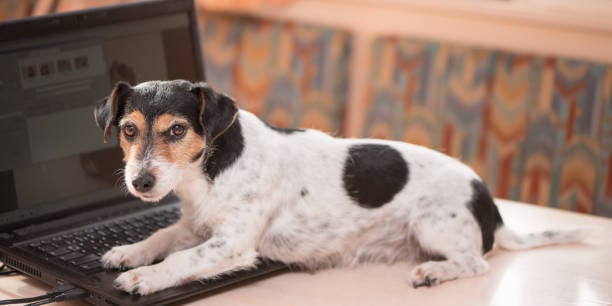Thinking of starting your very own dog grooming business, or incorporating grooming services into your new dog daycare resort or boarding facility? Maybe you've always been a dog lover ever since you got your first pet as a kid, or you've dreamed of becoming a self-made entrepreneur and owning your own business. Whatever the case may be, you've come to the right place!
At Gingr, we've helped hundreds of pet-care professionals get their businesses up and running. With the help of our pet business software, groomers, boarders, and daycare owners can stay organized and efficient with scheduling tools, communication features, and a speedy payment processing program. We've been around the block a few times, and we know what it takes to set yourself up to become the most pup-ular business owner around town.
We’ll cover the basics of creating a dog grooming business plan in the following sections:
- Key Questions to Ask Before Starting a Dog Grooming Business
- Components of a Successful Dog Grooming Business Plan
- Pet Grooming Business Plan Best Practices
As with any new business, starting a pet business comes with its own set of risks. But as the saying goes: nothing ventured, nothing gained. The benefit of owning your own business is that YOU have the power to make your own decisions, course correct when you face challenges, and reap the direct benefits of your hard work.
This guide will answer key questions, provide guidelines for creating your business plan, and offer concrete steps to take to get your business underway. Let's get started!

Key Questions to Ask Before Starting a Dog Grooming Business
Before you embark on your dog-grooming journey, there are probably a lot of questions on your mind about what starting a pet care business will entail. We've compiled some of the most frequently asked questions about starting a dog grooming business to help address your concerns.
How profitable is a dog grooming business?
Dog grooming has the potential to be a very profitable venture, but the success of your business will depend on a few factors:
- How quickly you can grow your customer base
- What you decide to charge for your services
- Your startup and operational costs
- The level of competition in the local market
Your profitability will depend on localized aspects such as the cost of rent or how many competitors there are in the area. You also may have to factor in new costs as you grow, such as employee wages. The average salary for a self-employed dog groomer can range from $15,000 to $100,000 per year.
The good news is that the pet industry is seeing a striking growth spurt, with an estimated $99 billion spent on pets in 2020. The global pet grooming market is projected to grow at a CAGR of roughly 7%–9%. We know that people are willing to spend piles of cash to pamper their pets. To become profitable, you must entice them to spend their money at your business rather than competitors’.
What is the best setup for a dog grooming business?
There are three main types of dog grooming businesses: at-home, mobile, and brick-and-mortar. One benefit of starting a dog grooming business is that you have a few options for how you want to set up your business.
Groomers can operate out of their residences, start a mobile dog grooming business using buses or vans (also referred to as a mobile dog grooming or mobile grooming business), or rent or purchase a space to set up their own dog grooming salon or grooming salon with a storefront. A dog grooming salon can also be located within a pet store, which can help attract foot traffic and potentially share rent costs.
Home-based grooming can be a cost-effective option for new groomers, allowing them to work at their own pace. Mobile dog grooming provides services directly to customers' homes, offering convenience and flexibility, but can require a larger initial investment in a grooming vehicle and equipment.
Brick-and-mortar grooming salons provide a permanent location for customers to bring their pets for grooming services, but typically have higher overhead costs due to rent and utilities. Brick-and-mortar salons can also offer extra services such as self-serve dog washing stations, which allow pet owners to wash their own dogs and provide an affordable, convenient option for pet hygiene.
Home and brick-and-mortar businesses are more traditional options, while mobile pet grooming is a rising pet industry trend. Each option has pros and cons, and each grooming business model has its own advantages and disadvantages, which should be considered based on the owner's goals and lifestyle.
Additionally, offering grooming services as an add-on at a veterinarian clinic can provide a steady stream of customers with lower startup costs.
Home business
-
Pros: You can eliminate commute time by running your business from home. Plus, you don't have to worry about overhead costs like commercial rent.
-
Cons: It can be hard to strike a work-life balance when working from home, and you'll have to rely on word of mouth or digital marketing as you won't have a physical storefront to draw in customers.
Brick-and-mortar store
-
Pros: Your business will benefit from having a physical presence and sign that can attract people passing by, and you can offer extra services to customers such as a self-wash station where they can wash their own dogs inside your facility.
-
Cons: You'll have traditional business costs such as commercial rent and utilities.
Mobile grooming
-
Pros: Taking your business on the road is convenient for customers, less stressful on pets, and a safer option for health-conscious clients during the pandemic.
-
Cons: You'll have to check local laws and regulations about where you can park your mobile business, and you'll have overhead costs for gas and vehicle maintenance.
As you can see, each option comes with advantages and disadvantages. Decide what matters most to you (having a flexible schedule, room to grow, lower operating costs, etc.) and go with the option that best aligns with your overall business strategy.
For example, say you have a dream to expand your business into a large operation with several staff members and a vast client base. In that case, you'd want to consider a brick-and-mortar store to have room to grow.
What do you need to start a pet grooming business?
You already have one of the most important assets needed to get your dog grooming business started—a passion for pets! In addition, here’s the basic equipment you’ll need to get your business underway:
- Bathtubs/sinks
- Doggie shampoo and nail clippers
- Grooming tables (a dedicated grooming table is essential for efficient and professional grooming)
- Pet clippers and grooming shears
- Deshedding and dematting tools
- Pet cages
- Dryers
- Puppy accessories (bows, bandanas, etc.)
- Cleaning supplies
- Grooming supplies (such as brushes, combs, and specialty shampoos)
- Grooming tools (including high-quality brushes, scissors, and other equipment)
- A well-designed grooming space (optimize your grooming area, bath area, waiting area, and self-serve stations for operational flow and customer experience)
Startup costs for a pet grooming business typically range from $10,000 to $50,000 depending on your business model. When itemizing your startup costs, be sure to include expenses for equipment, renovations, legal fees, and initial marketing. Most pet grooming businesses rely on personal savings and bank loans for funding, but you can also use credit cards or seek support from angel investors.
Along with your physical equipment, be sure to invest in a proper dog grooming business software system. Your business software can handle the organizational side of your business, from scheduling appointments to collecting payments. It will take much of the stress of running your business off your hands by allowing you to manage your digital processes more efficiently.
Finally, you’ll need a comprehensive business plan to give your business a solid foundation and a guide for completing your goals. Read on for an explanation of what a dog grooming business plan should look like.

Components of a Successful Dog Grooming Business Plan
Your dog grooming business plan offers a high-level overview of your business and can help guide your decision-making or help you access a business loan. If you are using this document to acquire a loan, be sure to tailor your language to be as persuasive and positive as possible to present your business as a dependable investment that will achieve long-term success. A comprehensive business plan should include an executive summary, management summary, financial projections, and details on day-to-day operations. Your business plan should include these seven sections:

Company Description
At the start of your business plan, introduce yourself and your vision for the business. Explain who you are and your qualifications. Describe the need in your community for this service and how your business will stand out from competitors (perhaps you’ll be a fully-mobile groomer or specialize in tough-to-groom breeds such as gigantic Newfoundlands or shaggy Old English Sheepdogs). It is important to define your business structure (sole proprietorship, LLC, or corporation) and clarify who the business is owned by, as this impacts liability and legal responsibilities.
Products and Services
In this section of your business plan, describe the pet grooming services, professional grooming services, and high quality grooming services you’ll be offering to customers. Will you just offer dog grooming services, or will you also provide products such as leashes, bandanas, or specialty dog shampoos?
Emphasize the unique features of your products and/or services (e.g., you’re the only mobile grooming company in town, or you’re the only business with a full line of boutique shampoos) that meet an existing need in the market. Be sure to include a clear pricing structure for all services and products. Creating a customer experience strategy is also essential for retaining clients and building relationships. Defining a niche within the pet grooming market can help differentiate your business from competitors.
Market Research
Prove your expertise in the pet grooming industry within the market research section of your business plan. Understanding the pet grooming industry, local market, and competition is crucial. Research what other groomers in your area are offering to identify market gaps and opportunities. Answer these questions as you research:
- Market need: What gap in the market do you intend to fill with your products and/or services?
- Competition: Who will be your local competitors? What do they have to offer?
- Pricing: How much are competitors charging for their goods and services?
- Target customer: What is your target market? Who are you trying to reach with your services? Consider pet owners and pet parents as your primary audience, and focus on how your brand as pet groomers will appeal to them.
Describe how your new business will fit into this puzzle and emphasize your competitive advantage. For instance, you might have special training or experience at national dog shows, a prime location, or state-of-the-art equipment. Any feature that your business will have that competitors lack gives your business an edge in the market that can draw in more investors. Networking with local pet owners and participating in community events can help build brand awareness.
Setting Specific, Measurable, Achievable, Relevant, and Timely (SMART) goals is essential for tracking your business progress. Creating a strong online presence will help attract new clients.
Marketing and Advertising
Describe your plan to market and advertise your business to attract customers. Perhaps you’ll launch a digital marketing campaign with targeted social media ads and geofencing strategies to reach people in a specific geographic location. You may also choose to send out direct mail flyers or purchase local radio or TV ad spots promoting your new grooming business.
Leverage a professional website, social media, Google Business Profile, and partnerships with local vets or pet stores to attract new clients. Offering loyalty programs can help retain clients and encourage repeat business in the dog grooming industry.
Use the data you gathered while creating the market research analysis to justify your marketing decisions. For instance, if you found in your market research that your target customer is likely a suburban resident in their early thirties to mid-fifties, you can place flyers in mailboxes in neighborhoods in your area as part of your marketing strategy.
Management Summary
Provide an outline of your management structure and descriptions of the key personnel involved. If you already have a few staff members on board, explain who they are and what their duties will be. If you’re bringing on additional staff members, describe the qualifications you’re looking for in new employees and what their day-to-day responsibilities will entail. If you plan to hire employees, note that you may need to obtain an Employer Identification Number (EIN) for tax purposes.
Financial Analysis
In this section, you’ll create a breakdown of important financial information. Include profit projections, a balance sheet, and cash flow statements:
-
Profit projections: Broadly, your profit will be your business’s total revenue minus total expenses. Your expenses will include variable costs (expenses that fluctuate regularly, including charges for hourly wages, cleaning services, etc.) and fixed costs (costs that rarely change, such as rent or utility payments).
Your revenue will be how many dogs you predict you’ll groom multiplied by how much your charge per dog. Use this information to create a profit projection chart for how you envision your business will stay profitable over the first five years of operation. -
Cash flow statement: Similarly, your cash flow statement will show how much money you need to make in a given period such as a month or year to remain in business. It will paint a picture of where the needed cash will come from and also where money will be flowing out of your business to pay for expenses.
-
Balance sheet: This is a breakdown of your assets and liabilities. Assets are your resources or investments that help your business generate income, such as your state-of-the-art grooming equipment. Liabilities are debts or financial obligations you owe such as loans or mortgages.
Overall, your financial section should include a profit breakdown and a more complex financial analysis for how you see your business growing over a five-year period. If you’re using your business plan to solicit a loan, be sure to include the monetary amount you’re seeking and what the funds will be used for. A comprehensive business plan is necessary for securing funding, and you must submit a convincing business plan to get a bank loan.
Legal Requirements
Prove that your business is qualified and fit for operation by describing how it adheres to all legal requirements.
First, define your business structure — whether you’re operating as a sole proprietorship, partnership, or corporation — and clarify who the business is owned by. If you decide to structure your business as a corporation, you’ll have to register with your state’s Secretary of State office. Registering your business as a corporation establishes it as a separate legal entity, protecting you from personal liability if you were to be sued by a customer.
You need to obtain a business license to operate your dog grooming business legally. Additionally, acquire any necessary animal care licenses and zoning permits to ensure compliance with local land use and animal care regulations. Some states require dog groomers to be licensed, which may involve passing an exam and completing training hours. Research and understand all necessary licenses and permits required to operate your dog grooming business legally.
Finally, research your options for business insurance and invest in a solution that meets your needs. Check out this guide to pet business insurance for detailed explanations of each type of insurance, including commercial liability insurance, professional liability insurance, and property insurance.
Commercial liability insurance covers your business as a whole if an accident were to take place such as a customer slipping on a wet spot and getting injured in your facility. Professional liability insurance accounts for liabilities that are directly related to grooming businesses, such as a dog being injured while getting a haircut. Lastly, property insurance protects your business if any unexpected disasters were to occur like a tornado or fire.
Once you’ve finalized your legal considerations, you’ll have a completed business plan to present to investors or use as a guiding force as you get started with your business. Be sure to take your time with this document. Think deliberately and realistically about your overall business strategy to create an accurate portrayal of your grooming business.

Pet Grooming Business Best Practices
In addition to creating a business plan, there are several best practices to adhere to that can take your grooming business to the next level. Offering loyalty programs is important for retaining clients and encouraging repeat business. These best practices include finding a niche, such as targeting specific customer segments like elderly pet owners, and providing tailored services to meet their needs.
This boosts loyalty by creating a customer experience strategy to retain clients and build relationships, networking with local pet owners and participating in community events to build brand awareness, and leveraging powerful dog grooming software to enhance customer experience by streamlining appointment scheduling and communication.
1. Define Your Pet Grooming Business Niche
Take the time to pinpoint your pet grooming business's niche and how you will describe this niche to potential customers.
First, define the breeds you will groom and how they will be served by your grooming business. For instance, will you serve all breeds, or specialize in a few such as large breeds?
Further, think deliberately about your grooming business operating concept — the setup you choose to run your business out of. For any setup you choose, decide which unique offerings you'll provide to customers. For example, if you choose a brick-and-mortar operation, you may decide to offer luxury doggie spa services to customers. Or, if you go with a mobile option, you can also provide dog-walking services.
However, you must also ensure the scope of your business is well-defined. You don't want to offer too much to customers and confuse them about the purpose of your business, or offer too little and cause them to go with a competitor's services instead. Take a Goldilocks approach and start by offering a few services that you can focus on growing and perfecting.
Defining your niche up front gives you a focus point for all your planning as well as more time to hone your business's concept. Once you have a clear picture of your business offerings, you'll be better positioned to enact effective marketing campaigns that describe your business more accurately.
2. Focus On Customer Experience
As a new business owner, it's critical to refine your customer service strategy. Providing clients with a streamlined, pleasant experience will keep them returning to your business each time their pet needs a trim.
As you gain new customers, keeping track of all customer interactions and pet information can quickly become an unwieldy task. This is where grooming business software can become a key asset to help you stay organized and give your customers an easy, hassle-free experience with your business.
For example, Gingr's grooming software allows groomers to develop appointment cards for each canine customer to track important information such as grooming history, behavior notes, and rates. You can use these cards to quickly access information at check-out time and schedule appointments while the customer is right in front of you.
Further, through your dog grooming business software, you can create custom email and text messages to ensure customers hear from you regularly and know when and how they can schedule their appointments.

3. Leverage Effective Dog Grooming Software
When thinking about ways to set your business apart from competitors, it’s clear that investing in quality dog grooming software will not only make your life as a business owner easier but provide a framework for growing your client base. Dog grooming business software has the following advantages:
- Saves time. You can schedule and view upcoming appointments, assign staff members to clients, and manage time-off requests all within one system. You won’t have to worry about keeping track of employee schedules or upcoming appointments within a complex spreadsheet or ad-hoc email chain.
- Helps you communicate more effectively. You can automated email and text messages to go out to customers to save you time from having to plan and manually send messages. This boosts your marketing efforts by ensuring regular communication between you and your customers.
- Increases profitability. Streamlined payment processing within your business software system ensures you get paid on time and accurately for your services. You can even increase your tip income by presenting tip options at check-out time.
Your business software is the last piece of the puzzle that will kick your business plan into high gear and impress prospective customers. Be sure to contact us here at Gingr with any questions about how dog grooming business software can enhance your business management operations and fit into your business strategy.
Set Your Grooming Salon Up for Success
Now that you have a solid understanding of how to create a dog grooming business plan and how to use your competitive advantage to set your business apart, you'll soon be ready to open your doors to a flood of new furry friends and give them the most stylish haircuts they'll ever receive. Be sure to check out these additional resources as you get prepped to open your business:
- Starting a Dog Grooming Business: The Complete Guide. Check out this article for another perspective on starting your very own dog grooming business.
- 10 Pet Industry Trends to Know. This guide outlines current pet business trends to consider implementing in your business.
Subscribe to the Gingr Blog







